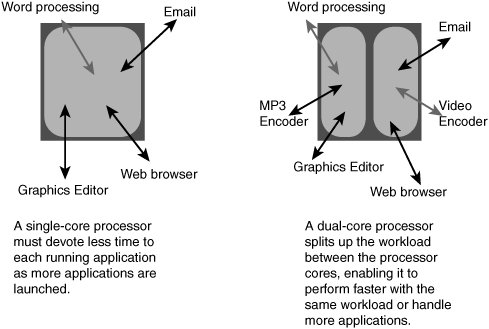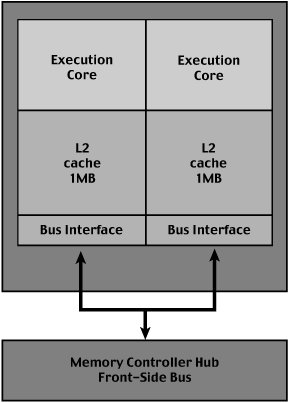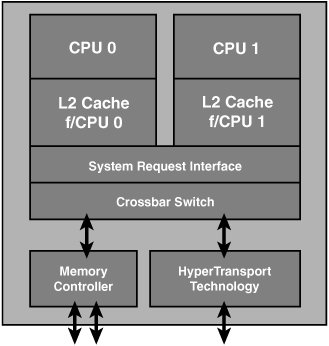Dual-Core Processors
| No matter how fast a conventional single-core processor operates or how much RAM is installed in a system, it must ensure that each program and process that is running is properly serviced. As more and more programs are opened, the amount of time the processor can devote to each program is reduced. The result is that system performance declines. Workstations and servers have long enjoyed the benefits of multiple processors, including better responsiveness when multitasking, faster performance in single multithreaded applications, and better overall throughput for both business and creativity applications (in terms of instructions processed per clock cycle). However, the high cost of multiprocessor motherboards and multiple processors has kept most desktop computer users from enjoying the same benefits. Note A multithreaded application can run different parts of the program, known as threads, at the same time in the same address space. They can share code and data. Currently, relatively few applications other than video editing programs are multithreaded. A multithreaded program runs faster on a dual-core processor or an Intel processor with HT Technology enabled than on a single-core processor. If you use multiple applications at the same time, such as email, web browsers, office suite components such as word processors and spreadsheets, graphics editors, and so forth, you should consider the latest development in processor technology: a dual-core processor. The dual-core processors introduced by Intel and AMD are designed to bring the benefits of multiprocessor operation to desktop systems by placing two processor cores in a single physical processor. Dual-core processors include two processor cores in the same physical package, providing virtually all the advantages of a multiple-processor computer at a cost lower than that of two matched processors. Unlike Intel's HT Technologywhich simulates two processors in a single physical unitdual-core processors do not need specific application support to improve performance. Dual processor cores provide more time to service each running application or application thread, providing faster performance in a multitasking environment. Intel introduced the first dual-core processors (the Pentium D and Pentium Extreme Edition) in early 2005, and AMD introduced its dual-core Opteron and Athlon 64 X2 processors shortly thereafter. Although both vendors offer dual-core processors, their designs are quite different in some ways, as are the systems that support them. Before looking at the specifics of these new processors, though, it's useful to determine whether you need a dual-core processor. Who Needs a Dual-Core Processor?A dual-core processor is designed for users who frequently multitask (run multiple programs at the same time) or who use multithreaded applications. Figure 3.66 illustrates how a dual-core processor handles multiple applications for faster performance. Figure 3.66. How a single-core processor (left) and a dual-core processor (right) handle multitasking. It's important to realize that a dual-core processor does not improve single-task performance. If you play 3D games on your PC, for example, it's very likely that's all you're doing at the time so no multitasking is taking place that would take advantage of a dual-core CPU. Until such time as games are designed to be multithreaded, gamers might prefer to choose a high-performance single-core processor instead of a dual-core processor. However, if you want to play 3D games at the same time as you perform other processor-intensive tasks, such as video or audio encoding, a dual-core processor might be a worthwhile investment. Benchmark tests indicate that some dual-core processors experience only slight slowdowns when playing a 3D game such as Doom 3 and performing other entertainment-oriented tasks such as audio or video encoding. Whether at work or play, a dual-core processor can help you get more done at once, if you use multiple applications. Intel Pentium D and Pentium Extreme EditionIntel introduced its first-dual core processors, the Pentium Extreme Edition and Pentium D, in April 2005. Although these processors used the code name Smithfield before their introductions, they are based on the Pentium 4 Prescott core. In fact, to bring dual-core processors to market as quickly as possible, Intel used two Prescott cores in each Pentium D or Pentium Extreme Edition processor. Each core communicates with the other via the MCH (North Bridge) chip on the motherboard (see Figure 3.67). Figure 3.67. The Pentium D and Pentium Extreme Edition's processor cores communicate with each other via the chipset's MCH (North Bridge) chip. For this reason, Intel 915 and 925 chipsets and some third-party chipsets made for the Pentium 4 cannot be used with the Pentium D or Pentium Extreme Edition. Intel's 945 series, 955X and 975X desktop chipsets, and E7230 workstation chipset are the first Intel chipsets to support these processors. The nForce 4 series from NVIDIA also works with these processors.
Because the Prescott core is the highest-wattage core Intel has produced for desktop computers and because each chip contains two cores, Intel has limited the speed of these processors to a maximum of 3.2GHzcompared to 3.8GHz for Pentium 4 processors. Even at a 3.2GHz top speed, however, the thermal design power of the Pentium Extreme Edition 840 and the Pentium D 840 is 130W, compared to 115W for Pentium 4 Prescott processors. The major features of the Pentium D include
The 830 and 840 models also include Enhanced Intel Speed Step Technology, which results in cooler and quieter PC operation by providing a wide range of processor speeds in response to workload and thermal issues. The Pentium Extreme Edition 840 is similar to the Pentium D 840, but with the following differences:
Table 3.53 compares the features of the various Pentium D and Pentium Extreme Edition processors.
Although a motherboard upgrade is necessary for most users of Pentium 4 processors to move to the Pentium D or Pentium Extreme Edition, the advent of dual-core processing is an exciting one, especially for those of us who are constantly running multiple programs at the same time. In 2006, look for new dual-core designs that will take advantage of the forthcoming 65-nanometer production process. These processors will run cooler than the processors shown in Table 3.52, which should allow for faster clock speeds. Intel Processor Model NumbersMost people associate clock speed with the processor, and Intel has always used the raw clock speed of its processors to market them. This has led many people to believe that faster-speed processors always result in faster or better systems, but that is not always the case. Processor architectures have a major effect on the performance of a processor, and it is entirely possible that a slower clock speed processor can handily outperform a faster one when running actual programs or doing real work. Unfortunately, this message is hard to convey when the main attribute used to market a chip is its raw clock speed. AMD has long been marketing its chips with model numbers, which in this case do relate to speedbut not directly. Starting in 2004, Intel also began to use model numbers, but its model numbering scheme is distinctly different from AMD's. Intel has decided to use a BMW-esque numbering scheme across its various processor families. Currently, it uses 8xx designations for its top-of-the-line desktop processors (Pentium Extreme Edition and Pentium D), 7xx for its Pentium M mobile processors, 6xx for advanced Pentium 4 processors, 5xx for mainstream Pentium 4 and mobile Pentium 4 processors, and 3xx for economy Celeron D desktop and Celeron M mobile processors. Dual-core Intel Xeon processors are numbered in the 7xxx series. Intel is not extending the numbering system to processor models already released. Thus, it will be useful for some time to come to use comprehensive references such as Table 3.47 for Pentium 4 processors because this table incorporates both processors with the numbering system and those that were introduced before the numbering system was developed. When creating the specific model number for a chip, Intel takes into account not only the raw clock speed of the chip, but also the internal architecture, cache sizes, bus speeds, and other features. In general, the higher the number, the more feature-rich the processor. In addition, within each series, the higher numbers are generally faster chips. Examples of the model numbers currently assigned to Pentium Extreme Edition, Pentium D, Pentium 4, and Celeron D processors are shown in Table 3.54.
Not all 8xx chips are faster than 6xx chips, and not all 5xx chips are faster than 3xx chips. The model numbers are not strictly comparisons of speed and certainly don't pertain to speed comparisons outside the model line. For example, using the BMW automobile analogy from which these numbers seem to be derived, some 3-series cars are faster than some 5-series cars, and some 5-series cars are faster than some 7-series cars. However, as you go up in the series numbers, the higher-numbered series generally have more features or are premium models. Within a particular series, the model numbers do give somewhat of an indication of speed, in that a Pentium 4 660 is faster than a Pentium 4 650, and so on. It will be interesting to see how these model numbers play out in the marketplace. There are indications that Intel might change its processor numbering system again in 2006. Whatever Intel, or AMD for that matter, decides to do with processor naming, I wouldn't purchase either an Intel or an AMD chip for an upgrade or as part of a new computer without knowing what the true clock speeds are, as well as knowing the cache sizes and other features in the chip. As we have seen, the model numbers don't strictly tell that and are useful only for a rough comparison. AMD Athlon 64 X2 and Dual-Core Opteron ProcessorsOne of the ironies of the processor business is that AMD, whose 64-bit Athlon 64 and Opteron processors were designed with dual-core updates in mind from the very beginning, was actually the second x86 chip vendor to introduce dual-core chips. AMD's first dual-core Opterons were introduced just after Intel's Pentium Extreme Edition and Pentium D in April 2005, and the desktop Athlon 64 X2 was introduced in May 2005. The Athlon 64 X2 uses two core designs:
Other major features of the Athlon 64 X2 include
The dual-core Opteron processors are available in all three series at speeds ranging from 1.8GHz (x65) to 2.4GHz (x80):
Although AMD was not the first to introduce dual-core chips, there are several advantagesespecially for existing Socket 939 Athlon 64 and all Opteron usersto the AMD approach. The design of these processors has always included room for the second processor core along with a crossbar memory controller to enable the processor cores to directly communicate with each other without using the North Bridge, as with Intel's initial dual-core processors. Figure 3.68 illustrates the internal design of the Athlon 64 X2. Figure 3.68. The Athlon 64 X2 use the integrated crossbar memory controller present from the beginning of the Athlon 64 processor design to enable the processor cores to communicate with each other. The result is that most existing systems based on Socket 939 Athlon 64 and Socket 940 Opterons can be upgraded to a dual-core processor without a motherboard swap. As long as the motherboard supports the 90-nanometer production process versions of these processors and a dual-core BIOS upgrade is available from the motherboard or system vendor, the upgrade is possible. Another benefit of AMD's approach is the lack of a performance or thermal penalty in moving to a dual-core design. Because the Athlon 64/Opteron design included provisions for a dual-core upgrade from the beginning, the thermal impact of the second core is minimal, even though the dual-core processors run at the same speeds as their predecessors. For example, the hottest Athlon 64 X2 models (running at 2.4GHz or 2.2GHz) dissipate only 110W of heat, compared to 130W for the Pentium Extreme Edition and Pentium D. Most 2.2GHz Athlon 64 X2 models dissipate only 89W, which is the same wattage as the 2.4GHz versions of the Athlon 64 single-core processors. Although the clock speeds of the Athlon 64 X2 and the Opteron are slower than Intel Pentium D or Pentium Extreme Edition processors, the increased efficiency of AMD's design provides performance that's comparable to or better than Intel's processors, depending on the benchmark. Table 3.55 provides a detailed comparison of the various Athlon 64 X2 processors.
The ability to upgrade most existing Socket 939 Athlon 64 and all Opteron systems with a dual-core processor opens the way for many users to move into dual-core computing with minimal difficulty. As with Intel's dual-core processors, AMD's dual-core processors are best suited to users who multitask or run multithreaded single applications. Gamers are still advised to use the fastest single-core processor, which in AMD's case is the fastest Athlon 64 FX series currently available. | |||||||||||||||||||||||||||||||||||||||||||||||||||||||||||||||||||||||||||||||||||||||||||||||||||||||||||||||||||||||||||||||||||||||||||||||||||||||||||||||||||||||||||||||||||||||||||||||||||||||||||||||||||||||||||||||||||||||||||||||||||||||||||||||||||||||||||||||||||||||||||||||||||||||||||||||||||||||||||||||||||||||||||||||||||||||||||||||||||||||||||||||||||||||||||||||||||||||||||||||||||||||||||||||||||||||||||||||||||||||||||||||||||||||||||||||||||||||||||||||||||||||||||||||||||||||||||||||||||||||||||||||||||||||||||||||||||||||||||||||||||||||||||||||||||||||||||||||||||||||||||||||||||||||||||||||||||||||||||||||||||||||||||||||||||||||||||||||||||||||||||||||||||||||||||||||||||||||||||||||||||||||||||||||||||||||
EAN: 2147483647
Pages: 283


